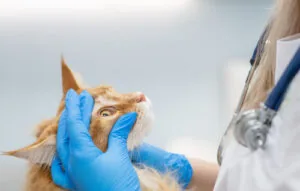What Happens During a Veterinary Dental Cleaning?

About 85% of pets have gum disease by the time they reach the age of three. Such diseases can progress far enough to even be life-threatening, and they can take up to two years off of a pet’s life. These statistics are so high. Many people, do not, unfortunately, know how to take proper care of their pet’s teeth. For this reason, pets suffer.
Taking your pet to the vet for regular teeth cleanings is the best way to combat this trend. It could help put your dog or cat in the 15% of animals who do not acquire serious gum and teeth conditions.
Trained veterinary professionals can clean your pet’s teeth the way no one else can. They can do this for an animal if the animal is put under anesthesia. The anesthesia helps the vet get to places that are hard to reach without the dog or cat feeling pain.
Now you know the benefits of having your pet’s teeth cleaned! You may be wondering what a day of dental cleaning might be like for your pet, so we have outlined that for you below!
Preliminary Appointment
Your doctor will ask you to bring in your pet a few days before the cleaning for an appointment.
At the appointment, your vet will take some blood tests to make sure your pet is able to handle surgery. The blood is sent off to a lab and when the results come back your vet will be able to ensure you pet is ready for a teeth cleaning and can confirm your pet’s dental cleaning appointment.
The Night Before
Pre-appointment preparation for your pet will be pretty simple. Most likely, your vet will ask for you to make sure your pet eats nothing the night before the surgery. You also should not feed your pet anything the morning of the surgery either. Fasting before the visit is important!
Morning Check-In and Drop-off
Your pet will most likely be checked in at the vet clinic or hospital in the morning, depending on their schedule. The dental cleaning itself only takes about 15-30 minutes, but the anesthesia, setup, exam, recovery (and any dental work that may be performed) adds to this time.
Most people drop off their pet and come pick them up later in the afternoon. You could also stay at the hospital while your pet’s teeth are cleaned. The vet hospital will make sure they have your cell number in case they need to reach you during the procedure. After the procedure is done, you will get a call to let you know you can come pick up your furry friend!
Anesthesia and Pre-Cleaning Setup
After your pet has been given propofol or telazol, your vet or vet technician will hook up your pet to the anesthesia machine.
The techs and the doctor will get all of the monitors and oxygen feed ready. A vet technician will help the vet monitor these machines throughout the procedure to make sure that everything is going well!
Oral Exam
During this step, the doctor will perform a thorough oral exam, including evaluating and recording each tooth for discoloration, fractures, abrasion, cavities, periodontal pockets and other factors. These observations are noted on the pet’s dental record.
Cleaning Below the Gumline
After the oral exam, your vet will typically get to work at cleaning beneath the gumline. This part of the procedure would be impossible for your pet to endure when awake. But with anesthesia, your pet will be able to have this area cleaned safely, quickly and thoroughly. This part of dental cleaning is very important because it cleans beneath the gumline where gingivitis and periodontal disease set in when buildup of plaque and bacteria get too high.
Scaling and Polishing
After the inner parts of the gums have been cleaned, your vet will begin working on your pet’s smile. He will use special scaling tools to scrape at the plaque and tartar build-up on the crowns of your pet’s teeth. This scaling procedure leaves your pet’s teeth looking quite beautiful, fresh, and clean again!
After he has finished scaling, your vet will polish and smooth the outer surfaces of your pet’s teeth to help deter the buildup of plaque and bacteria upon these surfaces. Once the polishing has been completed, your pet’s dental cleaning procedure will be done!
Recovery and Going Home!
After recovery, your dog or cat will most often be able to go home, and unless an additional procedure has been done, your pet can eat and return to normal.
Your vet will go over all findings from the procedure and give you any specific home care instructions. If extractions or other dental work was performed, your vet may prescribe pain medication and/or antibiotics along with a soft diet.
. . .
Your pet will leave with a sparkling smile and you’ll have the satisfaction of knowing that you’re helping keep your pet’s mouth healthy and clean!
Share This Post
Recent Posts
About Shallowford Animal Hospital
Shallowford Animal Hospital and The Pet Spa at Shallowford are dedicated to the exceptional, compassionate care your pet deserves. Pets hold a very special place in our families, and we treat yours like our own.



